ZEN MESTEREK ZEN MASTERS
« Zen főoldal
« vissza a Terebess Online nyitólapjára
鈴木 (祥岳) 俊隆
Suzuki (Shōgaku) Shunryū (1904-1971)
Dharma name: 祥岳 俊隆 Shōgaku Shunryū
Name used in Western culture: Shunryu Suzuki
Shunryu Suzuki-roshi, a Japanese Zen priest belonging to the Soto lineage, came to San Francisco in 1959 at the age of fifty-four. Already a respected Zen master in Japan, he was impressed by the seriousness and quality of "beginner's mind" among Americans he met who were interested in Zen and decided to settle here. As more and more people of non-Japanese background joined him in meditation, the San Francisco Zen Center came into being and he was its first abbot. Under his tutelage, Zen Center grew into City Center, Green Gulch Farm, and Tassajara Zen Mountain Center. He was undoubtedly one of the most influential Zen teachers of his time.
Shunryû
Suzuki rôshi and his relationship with
Kôjun Noiri (1914-2007) rôshi
[Sojun Mel Weitsman inteviewed]
MW: '71. Suzuki-roshi had asked Dick to see if he could invite Noiri-roshi to come to America to help us with authentic procedures for dharma transmission.
DC: He mentioned that to Ananda. Are you sure he mentioned it to Dick?
MW: It was common knowledge. Everybody knew it. I can't remember how it exactly came about. Suzuki-roshi wanted Noiri to teach us about dharma transmission because he didn't want us to do dharma transmission like they do it in Japan. He wanted us to have a meaningful dharma transmission, original dharma transmission which was more selective and not just handing out certificates. He didn't want it superficially or perfunctorily done.
DC: Suzuki-roshi had asked Noiri-roshi to come to a Tassajara Practice Period when he was well and he hadn't.
MW: Here was the thing that I heard. Both Niwa and Noiri had the same teacher, Kishizawa, and they were both going to be very prominent. So he asked one to be the recluse scholar and asked the other one to face the public. So Noiri-roshi was asked to be the scholar, the recluse, and the monk; and Niwa-roshi was asked to be the public face. That's the way they developed. They were dharma brothers.
Text in full: www.cuke.com/interviews/mel.html
Tuesday April 13, 1994--Rinso-in, Yaizu, Japan
[Hoitsu Suzuki Interviewed in Japanese by David Chadwick, translated by Kyoko Furuhashi and Shizuko Takatsuka.]
"In Showa 22 there was a jukai e (lay ordination ceremony) for lots of people, 400 or so, at Rinsoin and it was officiated by Kishizawa Roshi. My father thought people's minds were in a bad state because of the war so he decided to give the jukai e. [In this way, by strengthening Buddhism and helping to spread the teaching of Kishizawa Roshi, he felt he could help to strengthen the country. Kishizawa Roshi was a nationally prominent teacher and my father respected him greatly??] He didn't go as far as zuishin (follow mind) with Kishizawa. He was monkasei of Kishizawa but not deshi or zuishin.
"Kishizawa's temple is only 4 kilometers from Rinsoin. He was a well known great scholar of Shobogenzo and Goi. Noiri was a zuishin of Kishizawa and although he wasn't Kishizawa's disciple he studied hardest. Many studied with Kishizawa."
D: "When did Shunryu start studying with Kishizawa?"
"I don't know. (looks for a book) Taisho 12 - Gyokuden-in kaisan (founding) - Kishizawa became the jushoku of that temple then."
Text in full: www.cuke.com/interviews/hoitsu-2.html
[Tomoe Katagiri, widow of Dainin Katagiri-roshi interviewed by David Chadwick]
David Chadwick: Why did Katagiri Roshi send you to Noiri Roshi's sesshin? Did he have a connection to Noiri?
Tomoe-san: Yes. You remember Yokoi Roshi? Yokoi Roshi [横井覚道 Yokoi Kakudō] is Hojo-san's very closest friend. And he respected Yokoi Roshi very much. Close friend. Same branch temple. And Noiri Roshi's temple was the branch temple of Rinsoin. The temple has a relation. Yokoi Roshi and Noiri Roshi have the same master -- Ian Kishizawa. Noiri Roshi is his disciple. And Yokoi Roshi was Ian Kishizawa's grand disciple. His master was Ian Kishizawa roshi's disciple. Chito Kishizawa. He was Kishizawa Roshi's direct disciple. He was not his son. . . . Kishizawa's school. Kishizawa's school never married. Nobody married. But Kishizawa Roshi adopted the child. Chito Kishizawa is not the blood child, but was adopted. So has the same last name. Has a dharma relation, but no blood relation. So Yokoi Roshi was Ian Kishizawa's grand disciple. And Noiri Roshi is Ian Kishizawa Roshi's disciple. So they practiced together. And Hojo-san also respected Kishizawa and Noiri Roshi. And he knows the way of Kishizawa and Noiri Roshi's practice. So when Kishizawa and Noiri Roshi had one-week sesshin he was invited as a teacher. Hojo-san and Yokoi Roshi suggested I go to one-week sesshin.
Text in full: http://www.cuke.com/Cucumber%20Project/interviews/tomoe.html

Funeral ceremony conducted by Niwa-rōshi, Katagiri-rōshi, and Moriyama-sensei [the young disciple of Noiri-rōshi] for Shunryū Suzuki rōshi on December 12, 1971.
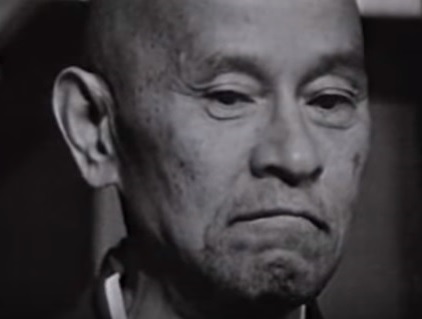
Tartalom |
Contents |
| Shunryu Suzuki [akadémiai ajánlás szerinti magyar átírás: Szudzuki Sunrjú] Kezdőké a zen szellem [Terebess Gábor címfordítása, egy latin szállóige: „Bátraké a szerencse” mintájára.]
Shunryu Suzuki Suzuki Shunryu: Te görbe uborka!
Sunrjú Szuzuki Sunrjú Szuzuki Sunrjú Szuzuki
|
Zen Mind, Beginner's Mind:
Branching Streams Flow in the Darkness:
Not Always So:
Crooked Cucumber: PDF: Zen Is Right Here & Now: Teaching stories and anecdotes
Shunryu Suzuki Lectures Chronology of Shunryu Suzuki's Life http://www.cuke.com/ PDF: Teaching Zen to Americans by Kim Boykin (2010) PDF: Suzuki Roshi Transcripts (1962-1971) PDF: Wind Bell, Vol. XI. 1972 Zen lineage chart of Shunryu Suzuki roshi (HTML) > PDF PDF: Wind bell teachings from the San Francisco Zen Center, 1968-2001 PDF: Zen Mountain Center Report, Wind Bell, Vol. VI. Nos. 2-4. Fall 1967 PDF: Shoes outside the door |
*
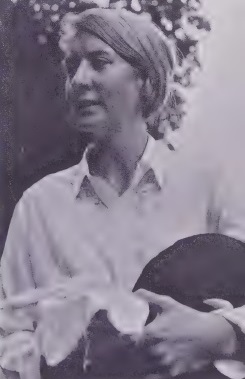
Trudy Dixon (1939-1969, Dharma name: 梅峰攝心 Baihō Sesshin). She was an early student of Shunryu Suzuki Roshi who transcribed and edited his classic book of talks, Zen Mind, Beginner's Mind.
Suzuki Roshi described her as a "real Zen master."
Suzuki-roshi's two calligraphies (如来 nyorai and 初心 shoshin) from the book Zen Mind, Beginner's Mind:
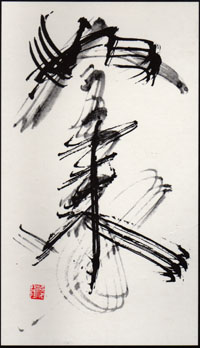
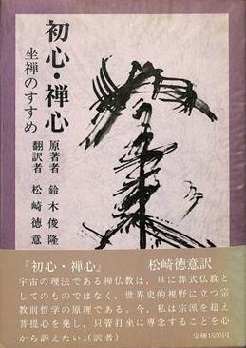 『初心 ・ 禅心』 (Japanese edition with Suzuki-roshi's calligraphy)
『初心 ・ 禅心』 (Japanese edition with Suzuki-roshi's calligraphy)
如来 Nyorai (Tathāgata)
The calligraphy on the front of the binding reads 如来 nyorai in Japanese or tathagata in Sanskrit. This is a name for Buddha which means "he who has followed the path, who has returned from suchness, or is suchness, thusness, isness, emptiness, the fully completed one." It is the ground principle which makes the appearance of a Buddha possible. It is Zen mind. At the time Suzuki-roshi wrote this calligraphy— using for a brush the frayed end of one of the large swordlike leaves of the yucca plants that grow in the mountains around Zen Mountain Center—he said: "This means that Tathagata is the body of the whole earth."
(Introduction to the 1970 edition of Zen Mind, Beginner's Mind, by Richard Baker). More yucca leaf calligraphy
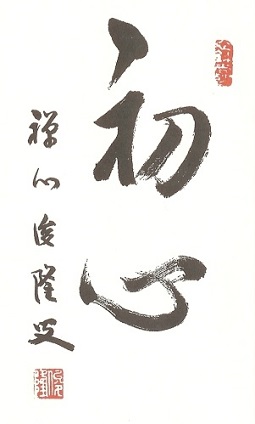
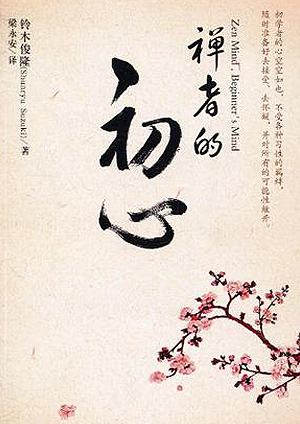 《禅者的初心》 (Chinese edition with Suzuki-roshi's calligraphy)
《禅者的初心》 (Chinese edition with Suzuki-roshi's calligraphy)
初心
Shoshin (Beginner's Mind)
禅心 俊隆 叟 Zenshin (Zen Mind) Shunryū sō (Old Shunryū)
Beginner's mind was a favorite expression of Dogen-zenji's. The calligraphy of the frontispiece, also by Suzuki-roshi, reads 初心 shoshin, or beginner's mind. The Zen way of calligraphy is to write in the most straightforward, simple way as if you were a beginner, not trying to make something skillful or beautiful, but simply writing with full attention as if you were discovering what you were writing for the first time; then your full nature will be in your writing. This is the way of practice moment after moment.
(Introduction to the 1970 edition of Zen Mind, Beginner's Mind, by Richard Baker)
Photos of Shunryu Suzuki-roshi
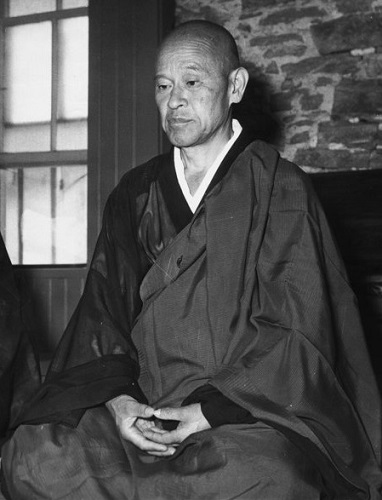
Suzuki-roshi sitting zazen, photograph by Tim Buckley 1967
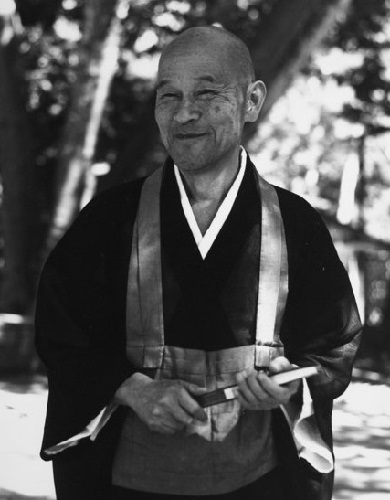
Suzuki-roshi at Tassajara, c1969
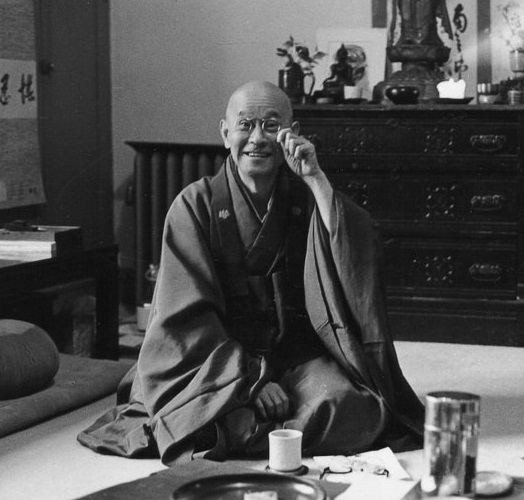
Suzuki-roshi at the City Center, San Francisco, c1970
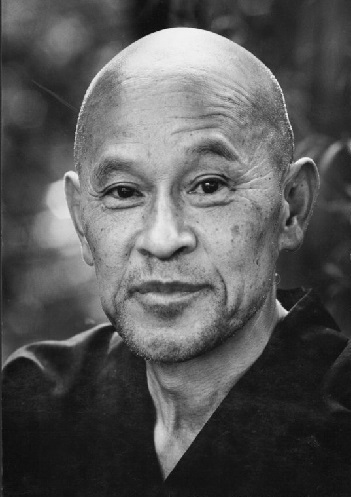
Suzuki-roshi c1970, portrait by Robert Boni
Two yucca leaf calligraphy sumie given by Shunryu Suzuki to Bob Watkins (1933 -2016):
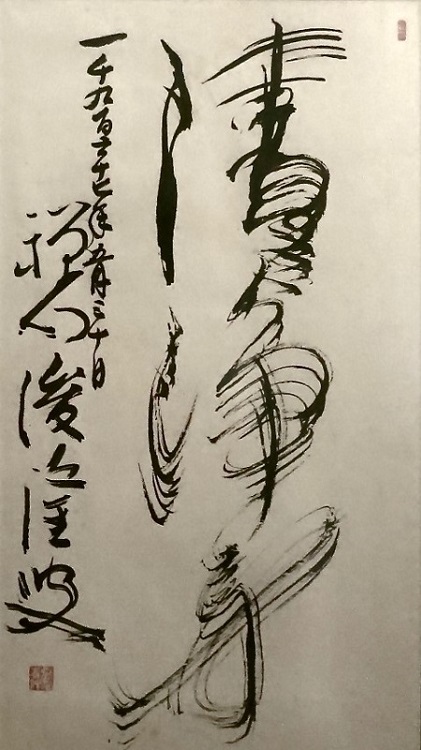
Suzuki said this one means Everything is Perfect.
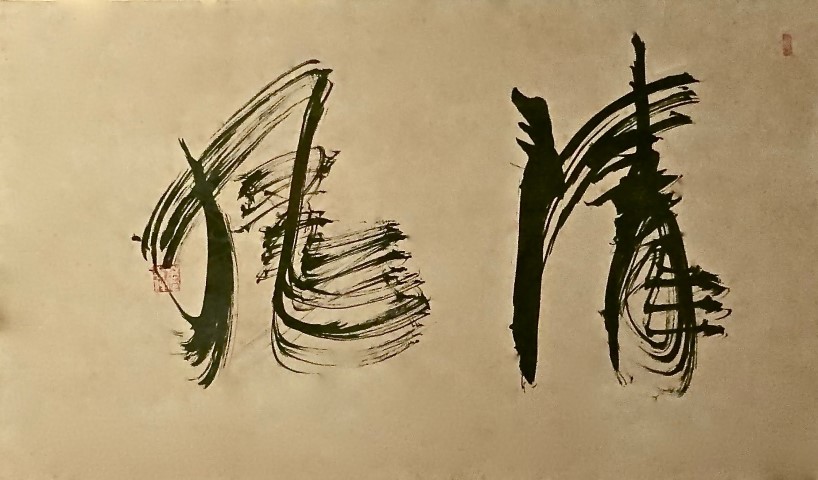
清風 Pure Wind (Reading R to L)
Zen lineage chart of Shunryū Suzuki rōshi
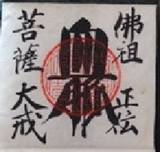
Suzuki rōshi's kechimyaku wrapper calligraphy
佛祖正傳菩薩大戒血脈
Busso shōden bosatsu daikai kechimyaku
The Bloodline of the Buddha's and Ancestors' Transmission of the Great Bodhisattva Precepts
It is worth mentioning that the line gets splitted apart
at Dajian Huineng and join back up at Eihei Dōgen
as the left-hand side is the Rinzai (Linji) line*,
and the right-hand side is the Sōtō (Caodong) line**,
reflecting Dōgen's early teacher Myōzen, as well as Rujing.
* 【黄檗・臨済系 法系】
南嶽懐譲和尚様から
佛樹明全和尚様
** 【曹洞系 法系】
青原行思和尚様から
天童如浄和尚様
Shakamunibutsu (Shākyamuni Buddha, Shijiamouni Fo 釋迦牟尼佛)
The Indian Patriarchs:
1. Makakashō (Mahākāshyapa 摩訶迦葉)
2. Ananda (Ānanda 阿難陀)
3. Shōnawashu (Shanakavāsa/Shānavāsin 商那和修)
4. Ubakikuta (Upagupta 優婆掬多)
5. Daitaka (Dhrtaka/Dhītika 提多迦)
6. Mishaka (Micchaka/Mishaka 彌遮迦)
7. Bashumitsu (Vasumitra 婆須密)
8. Butsudanandai (Buddhanandi 浮陀難提, 佛陀難提)
9. Fudamitta (Buddhamitra 浮陀密多, 佛陀密多)
10. Barishiba (Pārshva 婆栗濕婆, 脅尊者)
11. Funayasha (Puṇyayashas 富那夜奢)
12. Anabotei (Ānabodhi/Ashvaghoṣa 阿那菩提, 馬鳴)
13. Kabimora (Kapimala 迦毘摩羅)
14. Nagyaharajuna (Nāgārjuna 龍樹, 那伽閼樹那)
15. Kanadaiba (Kāṇadeva 迦那提婆 (提婆), 聖天)
16. Ragorata (Rāhulata/Rāhulabhadra 羅睺羅多)
17. Sōgyanandai (Saṃghanandi 僧伽難提)
18. Kayashata (Gayashāta 僧伽舍多)
19. Kumorata (Kumārata/Kumāralāta 鳩摩羅多)
20. Shayata (Jayata/Shayata 闍夜多)
21. Bashubanzu (Vasubandhu 世親, 天親, 婆修盤頭)
22. Manura (Manorata/Manorhita/Manothata 摩拏羅)
23. Kakurokuna (Haklenayashas 鶴勒那)
24. Shishibodai (Aryasimha/Simha Bhikshu/Siṃhabodhi 師子菩提)
25. Bashashita (Basiasita/Vasi Astia 婆舍斯多)
26. Funyomitta (Puṇyamitra 不如密多)
27. Hanyattara (Prajñādhāra/Prajñātāra 般若多羅)
The Chinese Patriarchs:
28/1. Bodaidaruma
(Bodhidharma, Putidamo 菩提 達磨 ?-532/5)
29/2. Taiso Eka
(Dazu Huike 大祖 慧 可 487-593)
30/3. Kanchi Sōsan
(Jianzhi Sengcan 鑑 智 僧 璨 ?-606)
31/4. Daii Dōshin
(Dayi Daoxin 大 毉 道 信 580-651)
32/5. Daiman Kōnin
(Daman Hongren 大 滿 弘忍 601-674)
33/6. Daikan Enō
(Dajian Huineng 大鑑 慧能 638-713)
34/7. Nangaku Ejō |
34/7. Seigen Gyōshi |
35/8. Baso Dōitsu |
35/8. Sekitō Kisen |
36/9. Hyakujō Ekai |
36/9. Yakusan Igen |
37/10. Ōbaku Kiun |
37/10. Ungan Donjō |
The Linji (Rinzai) Patriarchs: |
The Caodong (Sōtō) Patriarchs: |
38/11. Rinzai Gigen |
38/11. Tōzan Ryōkai |
39/12. Kōke Zonshō |
39/12. Ungo Dōyō |
40/13. Nan'in Egyō |
40/13. Dōan Dōhi |
41/14. Fūketsu Enshō |
41/14. Dōan Kanshi |
42/15. Shuzan Shōnen |
42/15. Ryōzan Enkan |
43/16. Funyō Zenshō |
43/16. Taiyō Kyōgen |
44/17. Tōshi Gisei |
|
45/18. Ōryū Enan |
45/18. Fuyō Dōkai |
46/19. Kaidō Soshin |
46/19. Tanka Shijun |
| 47/20. Reigen Isei (Lingyuan Weiqing 靈源 惟清 ?-1117) |
47/20. Chōro Seiryō [Shinketsu ~] |
| 48/21. Chōrei Shutaku (Changling Shouzhuo 長靈 守卓 c.1060-1130) |
48/21. Tendō Shōkaku [Wanshi ~] |
| 49/22. Muji Kaijin (Wushi Jiechen 無示 介諶 c.1080-1148) |
49/22. Setchō Chikan |
| 50/23. Mannen Donkan (Wannian Tanguan 萬年 曇貫 c.1100-117 |
50/23. Tendō Nyojō |
| 51/24. Setsuan Jūkin (Xuean Congjin 雪庵 從瑾 c.1117-1200) |
|
52/25. Koan Eshō (Xuan Huaichang 虛庵 懷敞 c.1125-1195) |
|
The Japanese Rinzai Patriarchs: |
|
| 53/26/1. Myōan Eisai (明菴 栄西 1141-1215) |
|
54/27/2. Ryōnen Myōzen (了然 明全 1184–1225) |
The Japanese Sōtō Patriarchs:
51/24/1. [Eihei] Dōgen Kigen
([永平] 希玄 道元 1200-1253)
52/25/2. Koun Ejō
(孤雲 懐奘 1198-1280)
53/26/3. Tettsū Gikai
(徹通 義介 1219-1309 )
54/27 /4. Keizan Jōkin
(螢山 紹瑾 1268-1325)
55/28/5. Gasan Jōseki
(峨山 韶碩 [峩山 紹碩]
1275-1366)
56/29/6. Taigen Sōshin
(太源 宗真 ?-1371)
57/30/7. Baizan Monpon
(梅山 聞本 ?-1417)
58/31/8. Jochū Tengin
(恕仲 天誾 1365-1437)
59/32/9. Shingan Dōkū
(眞巖 道空 1374-1449)
60/33/10. Sensō Esai
(川僧 慧濟 d. 1475)
61/34/11. Iyoku Chōyū
(以翼 長佑)
62/35/12. Mugai Keigon
(無外 珪言)
63/36/13. Nenshitsu Yokaku
(然室 輿廓)
64/37/14. Sessō Hōseki
(雪窓 鳳積)
65/38/15. Taiei Zeshō
(臺英 是星)
66/39/16. Nampo Gentaku
(南甫 元澤)
67/40/17. Zōden Yokō
(象田 輿耕)
68/41/18. Ten'yū Soen
(天祐 祖寅)
69/42/19. Ken'an Junsa
(建[遣]庵 順瑳)
70/43/20. Chōkoku Kōen
(朝國 廣寅)
71/44/21. Senshū Donkō
(宣岫 呑廣)
72/45/22. Fuden Gentotsu
(斧傳 元鈯)
73/46/23. Daishun Kan'yū
(大舜 感雄)
74/47/24. Tenrin Kanshū
(天倫 感周)
75/48/25. Sessan Tetsuzen
(利[刹]山 哲禪)
76/49/26. Fuzan Shunki
(富[冨]山 舜貴)
77/50/27. Jissan Mokuin
(實山 默印)
78/51/28. Sengan Bonryū
(湷[潛]巖 梵龍)
79/52/29. Daiki Kyōkan
(大器 敎寛)
80/53/30. Enjo Gikan
(圓成 宜鑑)
81/54/31. Shōun Hōzui
(祥雲 鳳瑞)
82/55/32. Shizan Tokuchu
(砥山 得枉[柱])
83/56/33. Nansō Shinshū
(南叟 心宗)
84/57/34. Kankai Tokuon
(觀海 得音)
85/58/35. Kosen Baidō
(古仙[佛] 倍道)
86/59/36. Gyakushitsu Sojun
(逆質 祖順 187?–1891)
87/60/37. Butsumon Sogaku
(佛門 祖學 1858-1933)
[鈴木 俊隆 Suzuki Shunryū's father; Gyokujun So-on's master]
88/61/38. Gyokujun So-on
(玉潤 祖温 1877-1934)
89/62/39. Shōgaku Shunryū
(祥岳 俊隆 1904-1971)
[鈴木 老師 Suzuki rōshi]
|
90/63/40.
Gyūgaku
Hōitsu (牛岳 包一 1939-) [鈴木 包一 老師 Suzuki Hōitsu rōshi; eldest son of Suzuki Shunryū] |
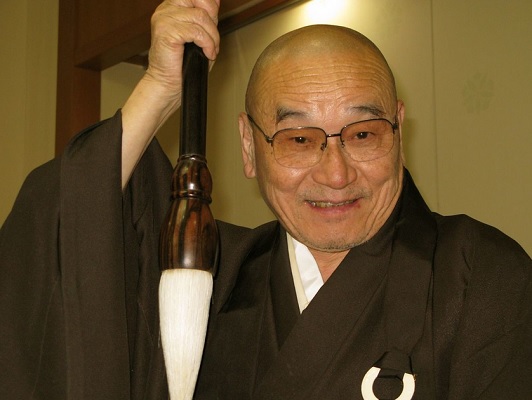
Hoitsu Suzuki line
Suzuki's Dharma name: 牛岳包一 Gyūgaku Hōitsu
A „másik" Suzuki: Suzuki Daisetz Teitaro (1870-1966)
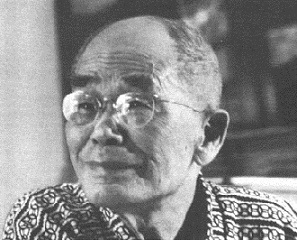
鈴木 大拙 貞太郎 Suzuki Daisetsu Teitarō, scholar and lay student of Shaku Sōen, Rinzai school; 釈 宗演 Shaku Sōen (1860-1919), heir of 今北 洪川 Imakita Kōsen (1816-1892), Rinzai school.
When people would confuse Shunryu Suzuki with the Harvard professor D.T. Suzuki, the roshi would say simply, "No, he's the big Suzuki, I'm the little Suzuki."
師は自分のことを偉大な禅学者鈴木大拙氏と比較して、 「小さな鈴木」 と謙遜して紹介したと言われます。 しかしその功績はとても大きなものがありました。
Shunryu Suzuki mestert ha Amerikában néhanap összetévesztették D. T. Suzukival, tréfásan válaszolt:
- Nem, én csak a kis Suzuki vagyok, ő a nagy Suzuki.